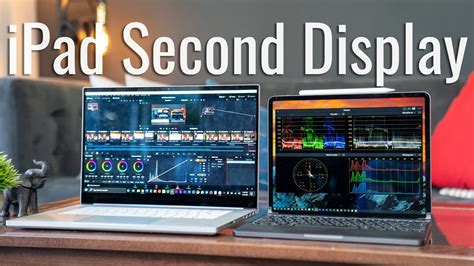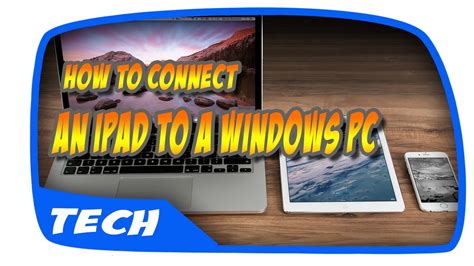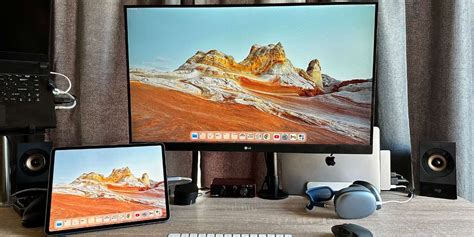Are you ready to step into the future of multitasking? Imagine being able to effortlessly expand your digital workspace across multiple screens, increasing productivity and efficiency like never before. With our simple and straightforward guide, you can turn your trusty Apple tablet into a versatile secondary monitor, providing you with the freedom to work in a whole new way.
Enhance your workflow with the power of synergy as you seamlessly integrate your iPad with your existing computer setup. No longer limited to a single screen, you can now take advantage of the spaciousness and flexibility that a dual screen environment offers. Whether you're a professional seeking to boost your productivity or a student looking to streamline your study sessions, this step-by-step tutorial will empower you to unlock the full potential of your Apple tablet.
Discover the possibilities that lie within your hands as you harness the transformational capabilities of your iPad. Embrace the opportunity to extend beyond the confines of a single device and experience the benefits of a portable and adaptable workstation. Through this comprehensive guide, you will learn how to seamlessly connect your iPad to your computer, configure the settings for optimal display performance, and maximize your newfound multitasking abilities.
Why Choose to Utilize Your iPad as an Additional Display?

Increasing productivity and optimizing workflow have become essential in today's fast-paced digital age. As technology continues to evolve, finding innovative solutions to enhance our daily tasks is crucial. One such solution involves repurposing your iPad as an extra monitor, offering an array of advantages and opportunities.
- Enhanced multitasking: By leveraging your iPad as a secondary display, you can seamlessly manage multiple tasks simultaneously. Whether you need to reference important documents, monitor real-time data, or collaborate across multiple applications, having an extra screen can significantly improve your workflow efficiency.
- Portability and versatility: The compact and lightweight nature of an iPad makes it a convenient companion for professionals on the go. Transforming your iPad into an additional display allows you to extend your workspace wherever and whenever you need it, without the constraints of a traditional monitor.
- Improved ergonomics: By utilizing your iPad as a second monitor, you can adjust your workstation setup to reduce strain on your neck and eyes. Placing the iPad at eye level helps maintain a more ergonomic posture, resulting in increased comfort during extended work sessions.
- Cost-effective solution: Repurposing your iPad as an extra monitor eliminates the need to invest in expensive hardware. It provides a budget-friendly alternative for individuals seeking to expand their screen real estate without incurring additional expenses.
- Seamless integration: With the availability of various apps and software, setting up your iPad as an additional monitor is straightforward. Many applications provide intuitive interfaces that enable effortless connectivity and synchronization, allowing you to seamlessly extend your desktop real estate.
By leveraging the distinctive features of your iPad and transforming it into an extra monitor, you empower yourself with a versatile tool that optimizes productivity, enhances portability, promotes ergonomic well-being, and offers a cost-effective solution to expand your digital workspace. The next sections will guide you through the step-by-step process of setting up your iPad as an additional monitor, unlocking its full potential.
Getting Your Devices Ready: Preparing for the Task
Before diving into the process of transforming your iPad into an additional display, it's crucial to properly prepare the devices involved. This section will guide you through the necessary steps to ensure a smooth setup.
- Check for Compatibility: Determine whether your iPad is compatible with the required software for extending the display. Ensure that both your iPad and the primary device you plan to connect it with meet the necessary specifications.
- Download and Update: Ensure that your iPad's operating system is up to date by downloading and installing any available updates. Similarly, check for the latest version of the software or app that enables extended display functionality.
- Connectivity Options: Familiarize yourself with the different connection methods for linking your iPad and primary device. You might have options like USB, wireless connection, or a combination of both. Understand the capabilities and limitations of each option.
- Gather the Cables and Accessories: Depending on the chosen connectivity method, gather the required cables, adapters, or accessories. Ensure that you have everything you need to establish a stable and secure connection.
- Charge Your Devices: It's essential to have both devices fully charged or connected to power sources before initiating the setup. This will prevent any interruptions or unexpected shutdowns during the process.
- Configure Device Settings: On your iPad, navigate to the display settings and configure them to align with your desired extended display preferences. Enable features like screen mirroring or extended desktop mode, following the provided instructions.
By following these preparatory steps, you'll set a solid foundation for turning your iPad into a functional and productive additional monitor. With your devices ready, you can now proceed to the next section to begin the setup process.
Connecting Your iPad to Your Computer

Once you have made the decision to transform your iPad into a useful second display, the next step is to establish a connection between your tablet and computer. This section will guide you through the process of connecting your iPad to your computer, enabling you to take full advantage of its additional screen space.
To begin, ensure that both your iPad and computer are connected to the same Wi-Fi network. This is essential for the seamless communication between the devices. Once you have confirmed the network connection, you can proceed to the next step.
The simplest and most common method of connecting your iPad to your computer is through the use of dedicated apps. These apps utilize the power of Wi-Fi and enable you to extend your desktop onto your iPad screen. You can find a variety of apps available in the App Store that cater to this purpose. Simply search for the desired app and install it on both your iPad and computer.
| Note: | Make sure to choose an app that is compatible with your computer's operating system. |
Once you have installed the app on your devices, launch it on both your iPad and computer. Follow the on-screen instructions to establish a connection between the two. Typically, this involves entering a unique code or scanning a QR code displayed on your computer screen using your iPad's camera.
After successfully pairing your iPad with your computer, you should see your iPad screen acting as an extension of your desktop. You can now arrange windows, drag and drop files, and enjoy the added productivity offered by the extra screen real estate.
Remember, the connection between your iPad and computer is wireless, meaning you can position your iPad anywhere within the Wi-Fi network range. This flexibility allows you to create a comfortable and customized dual screen setup that suits your workflow and preferences.
Now that you have successfully connected your iPad to your computer, you are ready to maximize your productivity by utilizing the additional screen space. Feel free to explore various applications and workflows that can streamline your work and enhance your multitasking abilities. Enjoy the benefits of having a versatile and portable second monitor at your disposal!
Configuring the Display Settings
Once you have transformed your iPad into an additional screen, it's time to customize the display settings to suit your preferences. In this section, we will explore various options to optimize and adjust the visuals on your new monitor-like iPad setup.
- Resolution: Adjust the resolution of your iPad's display to ensure crisp and clear visuals. Higher resolution settings provide sharper images but may require more processing power.
- Orientation: Choose whether you want your iPad to be in landscape or portrait mode. Landscape mode is ideal for widescreen content and multitasking, while portrait mode is suitable for reading documents or browsing the internet vertically.
- Brightness: Modify the brightness level of your iPad's display to achieve the desired lighting conditions. A higher brightness setting enhances visibility, especially in well-lit environments, while a lower setting conserves battery life and reduces strain on your eyes in dimly lit areas.
- Color Settings: Fine-tune the color balance, saturation, and contrast to create a visually pleasing experience. Adjusting these settings can help match the colors on your iPad's screen with the primary display, achieving a more consistent visual experience across multiple screens.
- Refresh Rate: Depending on your iPad model, you may have the option to adjust the refresh rate. Higher refresh rates provide smoother animations and scrolling, resulting in a more fluid user experience.
By taking the time to configure these display settings, you can optimize your iPad's additional screen as per your specific requirements. Experiment with different options to find the perfect setup that enhances productivity and visual appeal.
Using Your iPad as an Extended Display

Expanding the functionality of your iPad by utilizing it as an extended display can greatly enhance your productivity and multitasking capabilities. By connecting your iPad to your computer, you can create a second screen that provides additional space to work with.
Using your iPad as an extended display offers a seamless and efficient way to manage multiple tasks simultaneously, whether you are a professional, student, or simply looking to optimize your workflow. With its portable nature and touch screen capabilities, the iPad makes for an ideal extended display that can be easily integrated into your existing setup.
- Increased Workspace: By utilizing your iPad as an extended display, you can expand the screen real estate of your computer, giving you more space to organize windows, applications, and files. This additional workspace can help you manage complex projects or streamline your workflow.
- Improved Multitasking: Having an extended display allows you to multitask more efficiently. You can, for instance, view reference materials on your iPad while working on your main computer screen or use your iPad as a dedicated space for monitoring emails or social media feeds.
- Enhanced Portability: Since the iPad is lightweight and portable, it can be easily carried to different locations, making it a convenient solution for individuals who are constantly on the move. Whether you're working in a coffee shop, meeting room, or traveling, you can use your iPad as an extended display wherever you go.
- Intuitive Touch Screen Interface: The touch screen functionality of the iPad adds an extra layer of interactivity to your extended display experience. You can directly interact with content on your iPad, making it particularly useful for tasks such as drawing, note-taking, or navigating through applications.
- Easy Setup and Compatibility: Setting up your iPad as an extended display is a straightforward process. There are various apps and software available that enable seamless connectivity between your iPad and computer. Additionally, this functionality is compatible with both Windows and Mac operating systems.
Incorporating your iPad as an extended display offers a range of benefits that cater to different needs and work styles. By maximizing the potential of your iPad, you can create a more productive and efficient work environment.
Enhancing Your iPad as a Secondary Display
Exploring the full potential of your iPad as an additional screen can greatly enhance your productivity and multitasking abilities. By optimizing its capabilities as a secondary monitor, you can expand your digital workspace and streamline your workflow.
To fully utilize your iPad as a secondary display, it is important to understand the various optimization techniques available. Below, we will delve into a range of strategies and settings that can maximize the efficiency and functionality of your iPad as an extended monitor.
1. Adjusting Display Settings:
In order to provide the best viewing experience, start by fine-tuning the display settings on your iPad. Experiment with the brightness, contrast, and color calibration to ensure a comfortable and accurate representation of your content. Additionally, exploring the different display modes available can optimize the visual display for various tasks and preferences.
2. Optimizing Touch Controls:
Effortlessly interact with your iPad's secondary display by customizing the touch controls. Enable features such as touch gestures and multi-finger gestures to navigate and interact intuitively with your applications. Familiarize yourself with the available touch options and tailor them to suit your specific workflow requirements.
3. Leveraging Productivity Apps:
Unlock the full potential of your iPad as a secondary monitor by utilizing productivity apps designed to enhance multitasking capabilities. Explore applications that enable seamless integration between your iPad and main device, enabling easy drag-and-drop functionality, cross-platform file sharing, and synchronizing of settings and data.
4. Creating a Productive Workspace:
To optimize your iPad's potential as a secondary display, create an ergonomic and efficient workspace. Consider investing in adjustable stands or mounts that allow you to position your iPad at the most comfortable viewing angle. Furthermore, organizing your digital workspace by arranging windows and applications strategically can enhance your overall productivity and workflow.
5. Collaboration and Presentation:
Make the most out of your iPad as a secondary display during collaborative work or presentations. Utilize applications that facilitate easy screen sharing and collaboration with colleagues or clients. By seamlessly extending your main display to your iPad, you can engage in interactive discussions, share content, and streamline collaboration.
| Technique | Description |
|---|---|
| Adjusting Display Settings | Fine-tune brightness, contrast, and color calibration to optimize the visual experience. |
| Optimizing Touch Controls | Customize touch gestures and multi-finger gestures for intuitive interaction. |
| Leveraging Productivity Apps | Use apps that enhance multitasking, file sharing, and synchronization between devices. |
| Creating a Productive Workspace | Invest in stands or mounts for comfortable viewing and organize windows strategically. |
| Collaboration and Presentation | Utilize screen sharing and collaboration apps for interactive discussions and presentations. |
Troubleshooting Common Issues

In this section, we will address common issues that you may encounter while using your iPad as an additional display. We will provide solutions and tips to help you overcome these challenges and ensure a seamless experience.
1. Connectivity Problems:
If you are experiencing difficulties connecting your iPad to your computer or laptop, there are a few troubleshooting steps you can follow. Ensure that both devices are connected to the same Wi-Fi network and that the necessary software or app is installed on both devices. Additionally, double-check that the cables and adapters being used are functioning correctly.
2. Display Quality Issues:
If you notice any issues with the display quality on your iPad as an extra monitor, such as pixelation or blurry images, there are a few factors to consider. Firstly, check the resolution settings on both your iPad and computer and ensure they are compatible. Adjust the display settings to optimize the image quality. Additionally, make sure that the iPad screen is clean and free from any fingerprints or smudges that may affect clarity.
3. Lag or Latency:
If you experience lag or latency when using your iPad as a second monitor, there are a few steps you can take to improve the performance. Check your Wi-Fi signal strength and consider moving closer to the router if needed. Close any unnecessary applications running in the background on both devices to free up system resources. Additionally, ensure that you are using the latest software updates for both your iPad and computer to benefit from any performance optimizations.
4. Compatibility Issues:
If you encounter compatibility issues between your iPad and computer or specific software applications, it is essential to check for any updates or compatibility requirements. Visit the official websites of the software or app in question to see if there are any known issues or recommended settings for using an iPad as an extra monitor. Additionally, check for any troubleshooting guides or forums for your specific setup to find solutions specific to your situation.
| Problem | Solution |
| Connectivity Problems | Check Wi-Fi connection, software installations, and cable connections. |
| Display Quality Issues | Adjust resolution settings, clean iPad screen, and check compatibility. |
| Lag or Latency | Check Wi-Fi signal strength, close background apps, and update software. |
| Compatibility Issues | Look for software updates, recommended settings, and troubleshooting resources. |
FAQ
How can I turn my iPad into an extra monitor?
To turn your iPad into an extra monitor, you can use a third-party app such as Duet Display or Air Display. These apps allow you to extend your computer's display onto your iPad wirelessly or through a USB connection. Simply download the app on both your iPad and your computer, follow the on-screen instructions, and you'll be able to use your iPad as an additional monitor.
Do I need any special equipment to turn my iPad into an extra monitor?
No, you don't need any special equipment. All you need is your iPad, a compatible computer (Mac or Windows), and a third-party app such as Duet Display or Air Display. These apps are designed to extend your computer's display onto your iPad, allowing you to use it as an extra monitor.
Can I use my iPad as an extra monitor for both Mac and Windows computers?
Yes, you can use your iPad as an extra monitor for both Mac and Windows computers. The third-party apps like Duet Display and Air Display are compatible with both operating systems, so you can easily extend your computer's display onto your iPad regardless of the type of computer you have.
Is it possible to use my iPad as an extra monitor wirelessly?
Yes, it is possible to use your iPad as an extra monitor wirelessly. Apps like Duet Display and Air Display allow you to connect your iPad to your computer using Wi-Fi or Bluetooth, eliminating the need for any physical cables. This makes it convenient and easy to use your iPad as an additional display.
Are there any alternative methods to turn my iPad into an extra monitor?
Yes, besides using third-party apps, you can also consider using apps like Splashtop Wired XDisplay or iDisplay, which offer similar functionality. These apps allow you to connect your iPad to your computer through a USB cable, turning it into an extra monitor. However, it is important to note that the availability and compatibility of these apps may vary depending on the device and operating system you're using.




